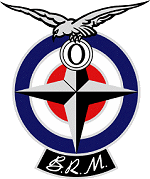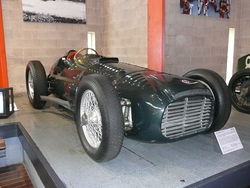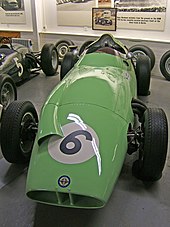British Racing Motors
 | |
| Full name | British Racing Motors |
|---|---|
| Base | Bourne, Lincolnshire, England |
| Founder(s) | Raymond Mays Peter Berthon |
| Noted staff | Alfred Owen Louis Stanley Jean Stanley Tony Rudd |
| Noted drivers | |
| Formula One World Championship career | |
| First entry | 1951 British Grand Prix |
| Races entered | 197 |
| Engines | BRM, Climax |
| Constructors' Championships | 1 (1962) |
| Drivers' Championships | 1 (1962) |
| Race victories | 17 |
| Pole positions | 11 |
| Fastest laps | 15 |
| Final entry | 1977 Italian Grand Prix |
| Formula One World Championship career | |
|---|---|
| First entry | 1951 British Grand Prix |
| Last entry | 1977 Italian Grand Prix |
| Races entered | 200 (189 starts) |
| Chassis | BRM, Lotus, Gilby, BRP, Scirocco, Brabham, Matra, McLaren, Cooper |
| Constructors' Championships | 1 (1962) |
| Drivers' Championships | 1 (1962) |
| Race victories | 18 |
| Podiums | 65 |
| Points | 499 |
| Pole positions | 11 |
| Fastest laps | 14 |
British Racing Motors (BRM) was a British
History
BRM was founded just after the
This proved to be an unwieldy way of organising and financing the project, and as some of the backers withdrew, disappointed with the team's slow progress and early results, it fell to one of the partners in the trust, Alfred Owen of the Rubery Owen group of companies. Owen, whose group primarily manufactured car parts, took over the team in its entirety. Between 1954 and 1970 the team entered its works F1 cars under the official name of the Owen Racing Organisation. Berthon and Mays continued to run the team on Rubery Owen's behalf into the 1960s, before it was handed over to Louis Stanley, the husband of Sir Alfred's sister Jean Owen.

A factory was set up in Spalding Road, Bourne, Lincolnshire, behind Eastgate House, Mays' family home, in a building called 'The Maltings' (the adjacent former ERA works, vacated in 1939).[1] Several people involved with ERA returned to the firm to work for BRM, including Harry Mundy and Eric Richter. The team also had access to a test facility at Folkingham aerodrome.
BRM V16
The first post-war rules for the top level of motor racing allowed 1.5-litre supercharged or 4.5-litre normally aspirated engines. BRM's first engine design was an extremely ambitious
The
Meanwhile, the organisers of all the grands prix counting for the world championship elected to run their races for
Crisis

The
The P25 was becoming highly competitive just as the rear-engined Cooper started to become dominant; the P48 was a quick reaction to this, using major components from the P25 but in rear-engined format. The P48 was revised for the 1.5 L rules in 1961, but once again BRM's own engine was not ready and the cars had to run with a Coventry-Climax four-cylinder unit in adapted P48 chassis, achieving very little in terms of results.
The firm moved to a purpose-built workshop on an adjoining site in the spring of 1960, but when the 1.5-litre atmospheric Formula One regulation was introduced in 1961, Alfred Owen was threatening to pull the plug unless race victories were achieved very soon.
Champions

By the end of the

As part of Owen's attempt to make BRM pay its way, the V8 engine was sold to privateers and appeared in a number of other chassis during the 1.5 L formula, particularly in private Lotus chassis and in smaller marques such as BRP.
A number of privateers acquired 1961 and 1962 BRMs during this period, including Maurice Trintignant and Scuderia Centro Sud; these cars continued to race for many years.
The monocoque
BRM H16

For 1966, the engine regulations changed to permit three-litre atmospheric (or 1.5-litre supercharged) engines. BRM refused Peter Berthon and Aubrey Woods's proposal to build a V12, and instead built an ingenious but very complicated engine, designed by Tony Rudd and Geoff Johnson, the H16 (BRM P75), which essentially used two flat-eight engines (derived from their 1.5L V8) one above the other, with the crankshafts geared together.

BRM found the H16 (2.75 x 1.925 in, 69.85 x 48.895 mm) attractive because it was initially planned to share design elements and components with the successful 1.5-litre V8. While the engine was powerful, it was also heavy and unreliable - Rudd claimed that his drawings were not followed accurately and many of the castings were much thicker and heavier than he had specified (when Lotus took delivery of their first H16 it took six men to carry it from the van to the workshop). At that time, BRM earned the nickname of "British Racing Misery". BRM,

The H16 engine was redesigned with a narrow-angle four-valve head and magnesium main castings to reduce weight and increase power, but was never raced (it was intended for the 1967 BRM P115) as BRM decided to use the V12 unit which was being sold to other F1 and sports car teams with encouraging results. [4] [5]
BRM V12

The H16 was replaced by a V12 (2.9375 x 2.25 in, 74.61 x 57.15 mm) designed by Geoff Johnson. It had been intended for sports car use, but was first used in F1 by the
The team regrouped with Tony Southgate as designer and Rodríguez brought back into the fold to partner Oliver, and gained its first V12 victory when Rodríguez won the 1970 Belgian Grand Prix in a P153, with further victories for Jo Siffert and Peter Gethin in 1971 in the P160. The team had reached one of its intermittent peaks of success. Both Siffert and Rodríguez were killed before the 1972 season and the team had to regroup completely again. Their last World Championship victory came when Jean-Pierre Beltoise drove a stunning race to win the rain-affected 1972 Monaco Grand Prix with the P160. He also won the non-championship 1972 World Championship Victory Race later in the year. The 1972 campaign was generally chaotic: having acquired major sponsorship (of Marlboro cigarettes, being the first team in the category to be sponsored by the brand), Louis Stanley originally planned to field up to six cars (three for established drivers, three for paying journeymen and young drivers) of varying designs including P153s, P160s and P180s and actually ran up to five for a mix of paying and paid drivers until it became obvious that it was completely overstretched and the team's sponsors insisted that the team should cut back to a more reasonable level and only three cars were run in 1973 for Beltoise, Lauda, and Regazzoni. At the end of the year, Marlboro would transfer its sponsorship to McLaren from 1974 (staying with the team until 1996).
Decline and fall

The last notable performance was Beltoise's second-place finish in the 1974 South African Grand Prix with the Mike Pilbeam-designed P201, a car with a pyramidal monocoque, very different from the curvy "Coke-bottle" Southgate cars. The Owen Organisation ended its support of the team and it was run on a lower-key basis by Louis Stanley and some of the Bourne personnel as Stanley-BRM until 1977. Old P201s were initially used, with the team hoping for a revival with the bulky and vaguely Ferrari-like P207 - which failed entirely.
Cereal millionaire and amateur racer
Side projects
The team became involved with
BRM were contracted by Chrysler (UK) Competition Department to develop a sixteen-valve cylinder head for the Hillman Avenger engine. It proved unreliable, underpowered, and unable to compete with the Ford rally team's proven Cosworth BDB-powered RS1600 Escorts.
BRM engine sales
The Owen Organisation expected BRM to turn a profit through sales of racing engines; the four-cylinder appeared briefly in a Cooper-BRM special for Stirling Moss but found no other customers. The V8 powered many 1.5-litre cars, including various private Lotuses and Brabhams as well as the BRP works team. Enlarged Tasman Series V8s of between 1.9 and 2.1 L were popular in 1966 as a stopgap before full three-litre engines were widely available. These units were also sold to Matra to power its early sports-prototypes.
A one-litre Formula Two engine was also made available, based on half of the F1 V8. This was not successful, in a formula dominated by Cosworth-Ford and eventually Honda engines.
Team Lotus used the ill-fated H16 engine, scoring its only win.
V12s were sold to other constructors of which the most notable were
Sponsorship and colours

The first BRMs were a pale duck-egg green (any shade of green represented

At one point in the 1960s Alfred Owen's brother Ernest wanted the team to paint their cars orange with black trim, orange being the Owen Organisation's corporate colour, used for a band around the nose of the cars and for the mechanics' overalls; Rudd (who didn't like the idea of orange BRMs) pointed out that orange was the
The team acquired significant
Later use of BRM name
BRM raced again as part of a project by
A special edition
In October 2008, a press release announced that Bee Automobiles Ltd 'BRM Bee Four ERV' would compete in the British Speed Hill Climb championships:
- "The 'BRM Bee Four ERV', code named the 'Watt 4', is an all-electric AWD (all-wheel-drive) vehicle capable of producing 700 hp or 520 kW. The ERV uses motor technology developed at Oxford University. The car is theoretically capable of reaching speeds of up to 250 mph. Participants in the project include Rubery Owen, Oxford University, Oxford Brookes and MIRA Ltd - Motor Industry Research Association. Paul Owen, Grandson of Sir Alfred and Managing Director of Rubery Owen's Environmental Technology Subsidiary Rozone Limited, commented: "Rubery Owen is very pleased to see the BRM name once again being used to drive forward an innovative development to take motorsport to new levels'"
As of 2011, the car had yet to leave the drawing board.[7][8][9][10]
In 2012, Bobbie Neate, granddaughter of Alfred Ernest Owen (who created Rubery Owen) and daughter of Jean Stanley (née Owen) wrote of her memories of BRM racing in the 1950s and 60s in her book Conspiracy of Secrets.
Formula One World Championship results
Grand Prix winners
The BRM team won seventeen Formula One Grands Prix as follows:
| Date | Race | Venue | Driver | Chassis | Engine |
|---|---|---|---|---|---|
| 31 May 1959 | Zandvoort | Jo Bonnier
|
P25 | 2.5L I4
| |
| 20 May 1962 | Zandvoort | P57 | 1.5L V8 | ||
| 5 August 1962 | Nürburgring | P57 | 1.5L V8 | ||
| 16 September 1962 | Monza
|
P57 | 1.5L V8 | ||
| 29 December 1962 | Prince George | P57 | 1.5L V8 | ||
| 26 May 1963 | Monaco | P57 | 1.5L V8 | ||
| 6 October 1963 | Watkins Glen | P57 | 1.5L V8 | ||
| 10 May 1964 | Monaco | P261 | 1.5L V8 | ||
| 4 October 1964 | Watkins Glen | P261 | 1.5L V8 | ||
| 30 May 1965 | Monaco | P261 | 1.5L V8 | ||
| 12 September 1965 | Monza | P261 | 1.5L V8 | ||
| 3 October 1965 | Watkins Glen | P261 | 1.5L V8 | ||
| 22 May 1966 | Monaco | P261 | 1.9L V8 | ||
| 7 June 1970 | Spa | P153 | 3.0L V12 | ||
| 15 August 1971 | Österreichring
|
P160 | 3.0L V12 | ||
| 5 September 1971 | Monza | P160 | 3.0L V12 | ||
| 14 May 1972 | Monaco | P160B | 3.0L V12 |
Exhibition
There is a small exhibition about Raymond Mays, including his interest in BRM, together with the trophies won by BRM while it was owned by the Owen Organisation, at
Computer simulation
A driveable, detailed virtual recreation of the BRM H16-powered P83/P115 and the BRM P261 was made available in the PC simulation Grand Prix Legends[11] that is based on the 1967 Formula One season. An unlicensed recreation of the 1968 BRM P126 can be found in rFactor 2.[12]
Reawakening
In celebration of BRM's 70th anniversary, John Owen, the 81-year-old son of BRM's original owner, the renowned industrialist, Sir Alfred Owen, has commissioned the build of three authentic 'new' 1950s V16 race cars. BRM's technical partners, Hall and Hall, used the original 'engine number two' a V16 power unit dating back to the 1950s, to help engineers overcome the technical challenges presented by one of the most complex Formula 1 engines of its day – each with more than 36,000 precision-engineered parts.
The re-built engine itself was cautiously tested at Hall and Hall's dynamometer at RAF Folkingham, Lincolnshire, where the original BRM Formula 1 engineering team worked during the 1950s. This particular engine has not been run since one of the original BRM team drivers, José Froilán González, then 77 years old, accidentally over-revved it during the at BRM's 50th anniversary celebration at Silverstone in 1999. It was comprehensively 'lunched', according to Hall and Hall technicians and has remained in storage ever since.
The three 'new' P15 V16 BRMs have been made possible by the discovery of three unused chassis numbers which were originally allocated to the racing programme, but never built due to a change in the Formula 1 technical regulations at the time.
The first car commissioned by John Owen is expected to be delivered and presented in public in 2021.
References
- ^ "The shambles, success and demise of Britain's first big F1 team". motorsport.com. 17 May 2020. Retrieved 29 January 2023.
- ^ Super Street Cars, 9/81, p.34.
- ^ "BRM Personnel". Archived from the original on 4 November 2013. Retrieved 2013-11-02. BRM Personnel
- ISBN 1-85960-666-0
- ISBN 1-899870-64-4
- ^ Hodgkinson, David John. "BRM P230 - The last BRM". British Racing Motors Information Centre. Retrieved 18 February 2013.
- ^ "2009 BRM Bee Four ERV - Images, Specifications and Information".
- ^ "BRM name for 800 BHP AWD electric race car". 9 January 2009.
- ^ "BRM Brand Revived with Bee Four Electric Racing Vehicle - Features 700bhp In-wheel Motors".
- ^ "Electric car to compete in British Hillclimb Championship". Archived from the original on 12 January 2022.
- ^ "IGCD.net: BRM P115 in Grand Prix Legends". igcd.net. Retrieved 11 June 2020.
- ^ "IGCD.net: BRM 126 in rFactor 2". igcd.net. Retrieved 11 June 2020.
Further reading
- BRM, Raymond Mays and Peter Roberts
- BRM: The Saga of British Racing Motors, Doug Nye with Tony Rudd, MRP - Volumes 1, 2 and 3 have appeared, covering the front-engined cars, spaceframe rear-engined cars and monocoque V8 cars respectively; Volume 4 will cover the H16, V12s and Can-Ams.
- It Was Fun, Tony Rudd, MRP.
- BRM V16, How Britain's auto makers built a Grand Prix car to beat the world, By Karl Ludvigsen, Published by Veloce
- The V12 Engine, Karl Ludvigsen, Haynes 2005.
- Conspiracy of Secrets, Bobbie Neate, Blake 2012
External links
- The British Racing Motors (official) website (2021).
- The British Racing Motors (unofficial) information centre.
- The story
- BRM personnel.
- The Owen Organisation trophies.
- Warwick University Archive - Owen Organisation documents.

